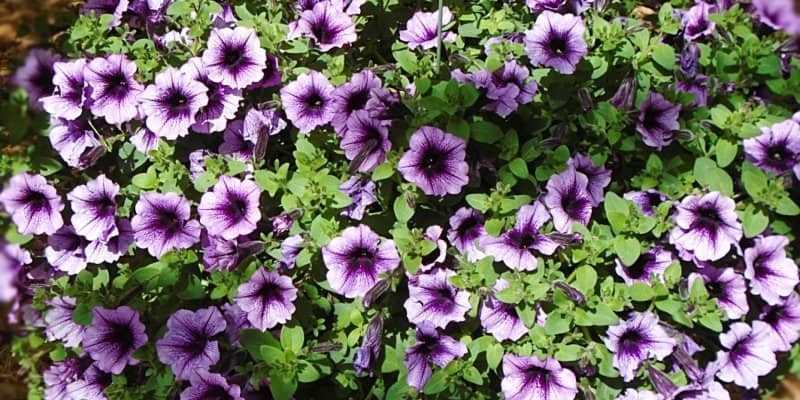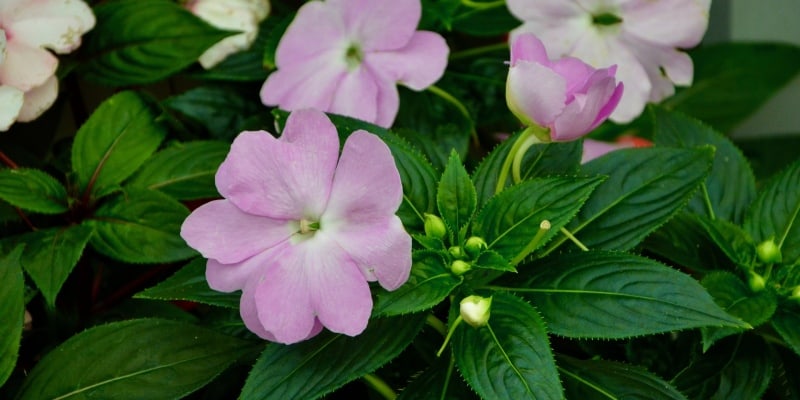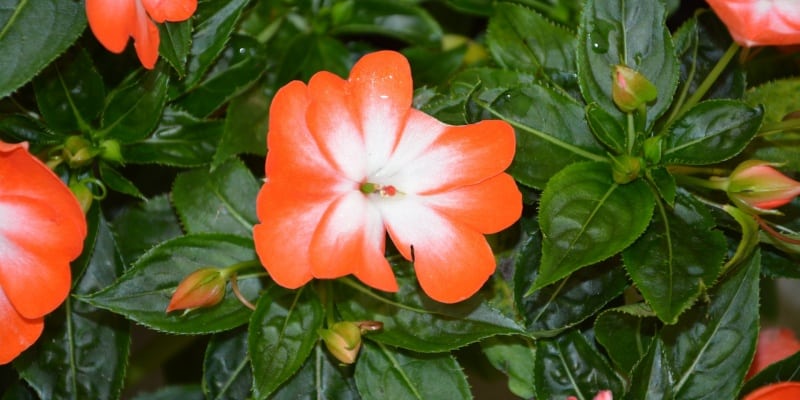Flower Glossary is reader-supported. When you buy through links on our site, we may earn an affiliate commission.
Impatiens flowers are herbaceous annuals that are mostly found in the Northern Hemisphere as well as the tropics. They earned the nickname, touch-me-not, because of their sensitive seed capsules. If you touch them, they will explode and shoot their seeds 20 feet away!
These plants are normally the go-to for many avid botanists because they bloom beautifully and come in several different colors. Their name is Latin for “impatient” because their seed pods are impatient to open up and burst when mature.
Impatiens require certain conditions for you to get the most out of these gorgeous plants. With that said, it is not too difficult to achieve! Let’s take a look at this plant genus and how best to look after them.

Table of Contents
Impatiens Overview
Impatiens come in a variety of colors except for blue. There are over a thousand different species of impatiens and they all have slightly different characteristics.
For example, the New Guinea impatiens are a hybrid. This species can take on more sunlight than the standard variety.
Another variety, called Busy Lizzies or Impatiens walleriana, are happier in the shade. They are called Busy Lizzies because they produce several blooms. Planting Busy Lizzies is a great way to brighten up those darker spots in your garden.
Impatiens have a variety of common names including jewelweed, snapweed, and patience. Although, the name “jewelweed” generally applies to the Nearctic species.
History of Impatiens
Impatiens originate from East Africa. In the 1800s, impatiens were brought to North America, England, France, Finland, Sweden, Poland, and the Netherlands.
Uses of Impatiens
Introducing impatiens to your garden will make a great addition to your landscape. You can use them in your flower beds or as a border to split the different features within your garden. They also make for a beautiful border along your pathways or sidewalk.
Impatiens also have some medicinal uses. They have anti-inflammatory and antifungal properties and contain 2-methoxy-1,4-naphthoquinone, which is an ingredient used in medications to treat hemorrhoids.
Some species of impatiens have also been used to treat skin issues such as insect bites, rashes, or bee stings. In ancient China, people used to mix impatiens with orchids and rose petals to make nail polish. Some jewelweeds contain a dye found in henna and mehndi.
You can also make a cooling tonic from their flowers. The healing properties of the plant mean that you can use this tonic to treat ailments such as skin rashes and sunburns. If you don’t have time to make a tonic, you can rub the petals directly on the burn or rash.
In addition, the plant has antifungal properties. You can use them to make an antifungal tonic to treat ailments such as athlete’s foot. They can also help with pain relief. You can either buy oil made from the plant or you can make a tincture from the stems and petals.
If you do buy a tincture or medicine made from impatiens, be sure to read the instructions carefully and follow them exactly. If you decide to make your own herbal remedy, it should not be for consumption. Only use your homemade concoctions topically.

How To Grow & Care For Impatiens
If you want to grow some Impatiens to brighten up your garden, you’ll be happy to know they’re quite easy to care for if you follow the right steps! Here is a quick guide on everything you need to know about growing and caring for impatiens. Follow these steps, and you’ll have beautiful blooms lighting up your garden in no time.
Light
The best environment for your impatiens to thrive in is the shade. Part of their appeal is their ability to succeed in completely shaded areas. With that said, they are also able to do well in partly shaded areas.
You want to avoid the full sun as this could give the leaves sunburn and hamper their growth. If this is unavoidable, you can plant them in full sun. However, they need to acclimate to this harsher light.
You must do this by gradually increasing the amount of light you expose them to over several days. You can do this easily if you plant your impatiens in containers or planters that you can move around your garden. A week should be adequate time to acclimate your impatiens to harsh light.
Soil
Impatiens like to be in moist soil. However, the soil must not be drenched. If they are left to sit in soaked soil, then their roots will rot, which will lead to diseases. It also helps to ensure that your soil contains organic material. This will allow your impatiens to thrive.
To ensure that the soil is moist, you need to water your impatiens frequently. You must make sure the soil does not retain too much water and become too boggy. You can check this by digging a hole in the ground that is about 12 inches deep and 12 inches wide. Fill the hole with water and wait for it to drain. Then, fill the hole with water again. This time, time how long it takes to drain.
If the hole drains by one inch per hour, this means that your soil is draining adequately. If it drains faster than this, then it could mean that your soil may become too dry. If it drains slower than this, then your soil retains too much water, and your impatiens may not grow successfully.
If your soil does not drain adequately, then you can plant your impatiens in a raised mound or bed. You can also plant your impatiens in a container or pot. Just make sure that your pot has adequate drainage holes at the bottom.
Water
Now that you have made sure your soil drains at the correct rate, you must ensure that you water your impatiens frequently. They require at least two inches of water per week. If the average temperatures are above 80 degrees Fahrenheit, then you need to make sure that your impatiens receive at least four inches of water per week.
If you have planted your impatiens in hanging pots or window boxes, make sure that you water your plants every single day. This is because those containers tend to drain much faster than the soil in the ground.
Fertilizer
Using fertilizer will make sure that your impatiens look their best but it’s not a necessary step. If you want to fertilize them, you can use a fertilizer that is water-soluble every two weeks. Apply the fertilizer throughout spring and summer. You can also use a slow-release fertilizer at the start of spring. Then, you reapply the fertilizer halfway through summer.
If your impatiens start to grow too much greenery before the plant has enough strength and dimension in its stem roots, this might be a result of over-fertilizing. You can remedy this by using scissors to cut off the top parts of their vegetation. This will allow new blooms to grow and will neaten up the appearance of the plant.
Temperature and humidity
Temperatures above 80 or 85 degrees Fahrenheit can be quite intense for impatiens. This is because they are rather sensitive to heat. Luckily, they should continue to grow successfully as long as you provide them with at least 4 inches of water per week.
In times of drought, your impatiens might become wilted. However, they are quite resilient and will bounce back to their beautiful appearance once you start to water them again. They are quite happy in humid conditions.
Since they are tropical plants, impatiens do not fare well in frosty conditions as they could turn into mush.
Pruning
You do not need to excessively prune your impatiens. They are self-cleaning plants. This means that the plant will remove their dead blooms themselves and will continue to grow new blooms throughout the season.
As we mentioned before, over-fertilization could make your plants become ‘leggy’. This is when they grow too much greenery before the stem has properly developed. The flowers will grow long and droop towards the ground. When this happens, you can prune the top third portion of the plant to neaten its appearance.
Placement
If you plant impatiens close together, they will grow taller than if you place them further apart. If you want them to stay close to the soil, plant them 8 or 12 inches apart. This is ideal if you want them to appear neat in your flower bed.
Although, for taller species, placing them about 1 foot apart is best as this will allow them enough space to grow to their full potential.
When buying your impatiens, make sure to check the species and whether it is a small variety or a tall one. This should help you determine how far away to plant them from one another.
Propagating Impatiens
Even when the weather is cold, impatiens are fairly easy to propagate. Planting them from seeds could take several months before they start to produce blooms. It is, therefore, easier to propagate impatiens over winter from cuttings taken in autumn.
You need to clip the shoot to be about 4 inches long, pinching off the bottom set of leaves, flowers, or seed pods. Place the cutting in water and set it out in a bright area out of direct sunlight. Once it has grown a good number of roots, transfer it to soil. Plant it in your garden in the spring once there is no more morning frost.
In summary – Quick Checklist For Planting
Let’s review the main things to remember when planting your impatiens.
- Once you have planted your impatiens in the ground, ensure that they receive at least two inches of water per week. When it’s very hot, make sure that you give them at least 4 inches of water per week.
- Try to plant them in an area that receives lots of rainfall. If this is not possible, then you need to supplement them by watering the plants yourself.
- Make sure that your soil drains adequately. If you have chosen to plant your impatiens in a container, ensure that they have adequate drainage holes.
- You can use a fast-acting fertilizer every two weeks. Alternatively, you can use a slow-release fertilizer once at the start of spring, and again halfway through summer.
- Finally, your impatiens will thrive in the shade. If exposing them to the harsh sun is unavoidable, make sure that you gradually introduce them to increasing intensities of sunlight over the course of a week.

Diseases and Other Obstacles
Downy Mildew
Since impatiens prefer to be in the shade or partial shade, this can often lead to mold diseases, like downy mildew. This is a water mold disease that lives in the soil. Downy mildew is a threat to impatiens and can kill them.
The mildew that attacks the impatiens is a pathogen called Plasmopara obducens. It forms in humid conditions in the spring or fall and it is very difficult to control. The spores from the mildew cause the leaves and flowers to become droopy and eventually die.
Unfortunately, there is nothing that can be done if the pathogen is already present in the soil. If downy mildew appears in your impatiens, the only option is to plant alternative ornamental flowers.
No Blooming
If your impatiens are not showing any blooms, this could be due to several reasons. Even though impatiens tend to do well in the shade, this could actually be the culprit. Try and expose them to more sunlight to encourage blooming.
Another reason could be dehydration. Remember, you want your soil to be well-drained but not dry. You also do not want your roots to sit in overly wet soil.
Your impatiens might also not be showing blooms due to overcrowding in your flower beds. Try to space your plants further apart.
Impatiens Varieties
There are around a thousand varieties of impatiens. They have different blooms and come in various colors like red, violet, orange, white, and pink. Let’s look at some of these varieties in more depth.
New Guinea Impatiens
The New Guinea Impatiens, otherwise known as the Applause Orange Blaze, features bright orange flowers and multicolored foliage. This variety can tolerate much colder weather than other impatiens. They grow to be about one foot tall and one foot wide.
Balsamina Impatiens
This variety has strong, sturdy stems and can grow as tall as 30 inches high. Its orange flowers grow in gorgeous clusters. Their blade-like leaves are a subdued, dark green. This particular variety does well if you start by planting their seeds indoors before moving them outside.
Bedding Impatiens
This variety grows extremely quickly. Because of this, they can overrun the weeds that grow in your garden. If you choose to include Bedding Impatiens in your garden, make sure that you give them plenty of water and plant them in partial shade.
Jewelweed Impatiens
There are several types of jewelweed impatiens including the spotted jewelweed, orange jewelweed, common jewelweed, and yellow or pale jewelweed.
They earn their name because they sparkle like jewels when they are in the sunlight.
These impatiens species like damp soil and partial shade. They can tolerate harsher sunlight in areas where the temperature is cooler.
They will germinate very well if you store them in the refrigerator for about two months before you plant them in your garden. Make that they are exposed to light, otherwise, they may not germinate.
Celebrette Deep Red
This variety is an excellent choice if you want to attract hummingbirds to your garden! These impatiens have beautiful red flowers with white centers. Their foliage is dark green and it can grow to be about 16 inches in height. These eye-catching flowers will make a striking focal point in your garden.
Painted Paradise
The Painted Paradise Impatiens is a type of New Guinea impatiens. It comes in four different colors: lilac, pink, red, and white. The Painted Paradise Lilac has multicolored foliage and can grow to be up to 14 inches tall. This plant has a more compact look compared to some other varieties. As the name suggests, its flower petals are a gorgeous lilac color.
The Painted Paradise Pink has the same compact look and grows to be 14 inches tall. Of course, its petals are a pretty pink color with white centers. The Painted Paradise Red is very similar except for its striking red petals.
The Painted Paradise White has a more unique look. The petals are large and white with a yellow center. They are complemented very well by their yellow and green leaves.
Final Thoughts
With thousands of varieties to choose from, impatiens will make a great addition to your garden. You can use them to brighten up your flower beds or to border your walkways.
There are no limits to the ways impatiens can add a bit of flair to your garden. With the thousands of different varieties available, the combinations you can implement in your garden are endless! These “impatient” plants will grow voraciously throughout the seasons and they do not require too much energy to help them succeed.